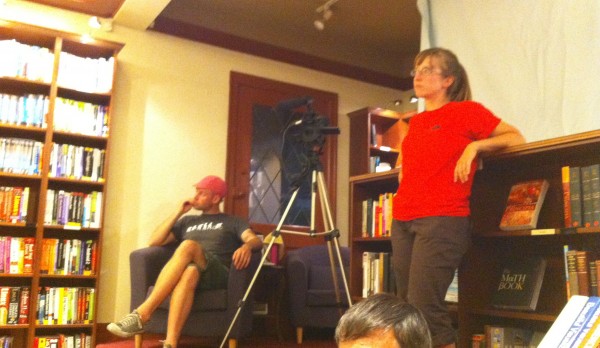
Bikestravaganza rolled into town Saturday evening for a chat at Ada’s Technical Books on Capitol Hill for a night of presentations, zines and discussions about bikes. Hailing from Portland, Joe Biel (filmmaker and founder of Microcosm Publishing) and Elly Blue (activist, organizer and former BikePortland.org editor) are touring the country with a zine library, a slideshow and open ears in an effort to facilitate a larger conversation about the good and bad in bike politics, infrastructure and culture. They bring lessons from Portland, often considered the most bike-friendly city in the country, and are gathering lessons to bring home at the end of their tour.
The night touched on a lot of issues, so I’ll focus on a couple in a series of posts this week. Part One looks at funding, both for bikes and for freeways.
$65 million: Top-tier bike infrastructure or one mile of freeway
First, a zoomed-out view of how Portland got where it is. Well, they spent $65 million dollars on infrastructure, mostly in the past 15-20 or so years. In the 90s, the city passed a bike master plan, and they have since spent money backing it up. $65 million is nothing to shake a stick at, but let’s put it this way: That’s the same cost of just one mile of freeway, they said during their presentation.
In 2000, Portland bike infrastructure reached a point where people started to feel like they could ride across the city without fearing for your life, said Blue during the talk. Since then, biking has exploded, with up to 30 percent of people in some neighborhoods using their bikes to commute at least some of the time.
Portland is also leading the way in the U.S. in implementing facilities like cycle tracks, bike boulevards and bike boxes. The Federal Highway Administration considers these facilities “experimental,” which creates impediments to further implementation (more on this issue later this week, stay tuned).
We can stop the Deep Bore Tunnel
We discussed the Deep Bore Tunnel, and we need to stay motivated and determined to stop this giant mistake. It’s not too late. Just look at what happened to Portland’s Mt. Hood Freeway:
Again, it only took Portland $65 million to be the top bike city in the nation. The tunnel will cost an estimated $2 billion, not counting cost overruns. If the city (or even the state) is hit with massive transportation overruns, how far back will that push the relatively cheap bike projects in the city and region?
Or how about this interesting math: Currently, 110,000 vehicles use the viaduct every day. According to a tolling study cited by the Stranger, only an estimated 47,000 vehicles will use the deep bore tunnel. The rest of those vehicles will likely pour into downtown streets or go over and clog up I-5 even more.
If just 20 percent of Seattleites rode bicycles to work, that would be 123,467 bikers. For the cost of the tunnel, you could build Portland’s bike infrastructure 30 times (or fund the pedestrian and bike master plans for the next 60 years), not to mention all the other needs in this city and state. And on top of this all, those 47,000 vehicles would have to pay $4 during peak hours just to use the tunnel.
Unless you own real estate near the viaduct, this is a rotten deal. I know there is tunnel opposition fatigue out there, but we need to get re-energized. I don’t want to ride my bike in a downtown Seattle grid with 64,000 more cars than it has currently, and I don’t want to put all other city and state projects in jeopardy due to a massively over-budget project that helps practically no one (drivers least of all).
It’s never too late to stop it. We’ve done it before. We have our own Mt. Hood Freeway of sorts. Look at what happened when citizens dug in against the Thompson Expressway. Can you even imagine a Seattle with that expressway in place?








Comments
5 responses to “Lessons from Bikestravaganza, Part 1: $65 million = World class bike city or 1 mile of freeway”
If the tunnel isn’t built and McGinnites get their way with the surface/transit solution, all 110,000 cars currently on the viaduct will end up on surface streets. This is the absolute worst case for cyclists according to the Gehl report everyone is fond of quoting. And your comparison of burying an elevated waterfront highway with stopping a new lake front highway is preposterous. Putting the viaduct traffic underground is analogous to what activists accomplished by stopping the Thompson Expressway – building the tunnel restores a waterfront and stopping the Thompson saved a waterfront. More on the tunnel at http://www.lightandair.wordpress.com.
Your key claim–that “If the tunnel isn’t built…all 110,000 cars currently on the viaduct will end up on surface streets. “–is wrong. Planners have known about the concept of induced demand for decades: if you build more road infrastructure, more people choose to drive (immediate effect) and choose to live and work in combinations of places that force them to keep driving (longer-term effect). Conversely, taking road infrastructure away reduces driving, especially when it’s coupled with transit improvements that give people better alternatives than they currently have.
[…] But we know very well how to design streets that ameliorate that risk. It doesn’t cost very much and it typically has little impact on car travel. All that’s missing is a shift of […]
[…] awesome folks at the Seattle Bike Blog have a series of excellent posts on what exactly went down and provide a good place to continue of the […]
[…] awesome folks at the Seattle Bike Blog have a series of excellent posts on what exactly went down and provide a good place to continue of the […]